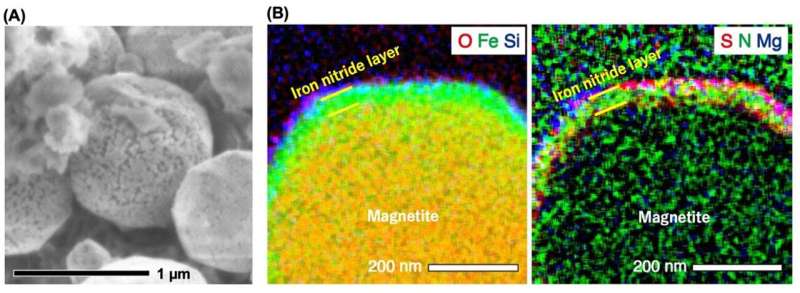This article has been reviewed according to Science X's editorial process and policies. Editors have highlighted the following attributes while ensuring the content's credibility:
fact-checked
peer-reviewed publication
trusted source
proofread
Meteorites likely source of nitrogen for early Earth, Ryugu samples study finds

Micrometeorites originating from icy celestial bodies in the outer solar system may be responsible for transporting nitrogen to the near-Earth region in the early days of our solar system. That discovery was published in Nature Astronomy by an international team of researchers, including University of Hawai'i at Mānoa scientists, led by Kyoto University.
Nitrogen compounds, such as ammonium salts, are abundant in material born in regions far from the sun, but evidence of their transport to Earth's orbital region had been poorly understood.
"Our recent findings suggest the possibility that a greater amount of nitrogen compounds than previously recognized was transported near Earth, potentially serving as building blocks for life on our planet," says Hope Ishii, study co-author and affiliate faculty at the Hawai'i Institute of Geophysics and Planetology in the UH Mānoa School of Ocean and Earth Science and Technology (SOEST).
The paper, "Influx of nitrogen-rich material from the outer Solar System indicated by iron nitride in Ryugu samples," was published in the journal Nature Astronomy.
Like all asteroids, Ryugu is a small, rocky object that orbits the sun. The Japan Aerospace Exploration Agency's Hayabusa2 spacecraft explored Ryugu and brought material from its surface back to Earth in 2020. This intriguing asteroid is rich in carbon and has undergone significant space weathering caused by micrometeorite collisions and exposure to charged ions streaming from the sun.
In this study, the scientists aimed to discover clues about the materials arriving near Earth's orbit, where Ryugu is currently located, by examining the evidence of space weathering in Ryugu samples. Using an electron microscope, they found that the surfaces of the Ryugu samples are covered with tiny minerals composed of iron and nitrogen (iron nitride: Fe4N).
"We proposed that tiny meteorites, called micrometeorites, containing ammonia compounds were delivered from icy celestial bodies and collided with Ryugu," said Toru Matsumoto, lead author of the study and assistant professor at Kyoto University. "The micrometeorite collisions trigger chemical reactions on magnetite and lead to the formation of the iron nitride."
The iron nitride was observed on the surface of magnetite, which consists of iron and oxygen atoms. When magnetite is exposed to the space environment, oxygen atoms are lost from the surface by the irradiation of hydrogen ions from the sun (solar wind) and by heating through micrometeorite impact. These processes form metallic iron on the very surface of the magnetite, which readily reacts with ammonia, creating ideal conditions for synthesis of iron nitride.
More information: Toru Matsumoto et al, Influx of nitrogen-rich material from the outer Solar System indicated by iron nitride in Ryugu samples, Nature Astronomy (2023). DOI: 10.1038/s41550-023-02137-z
Journal information: Nature Astronomy
Provided by Kyoto University





















